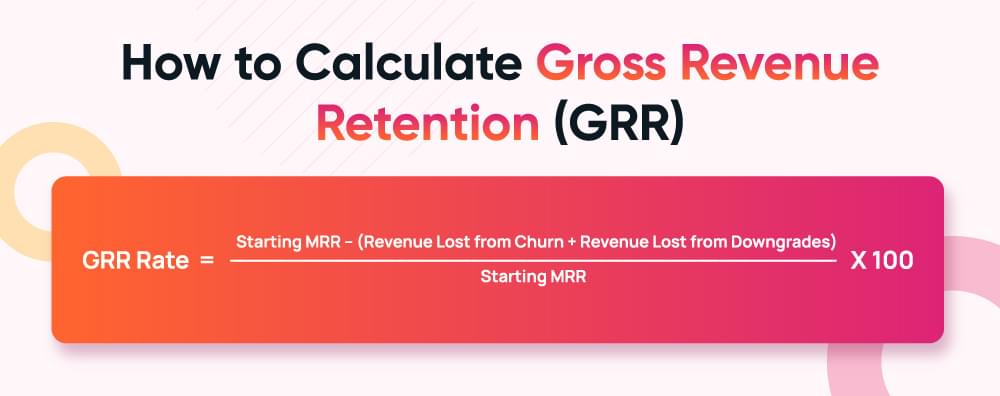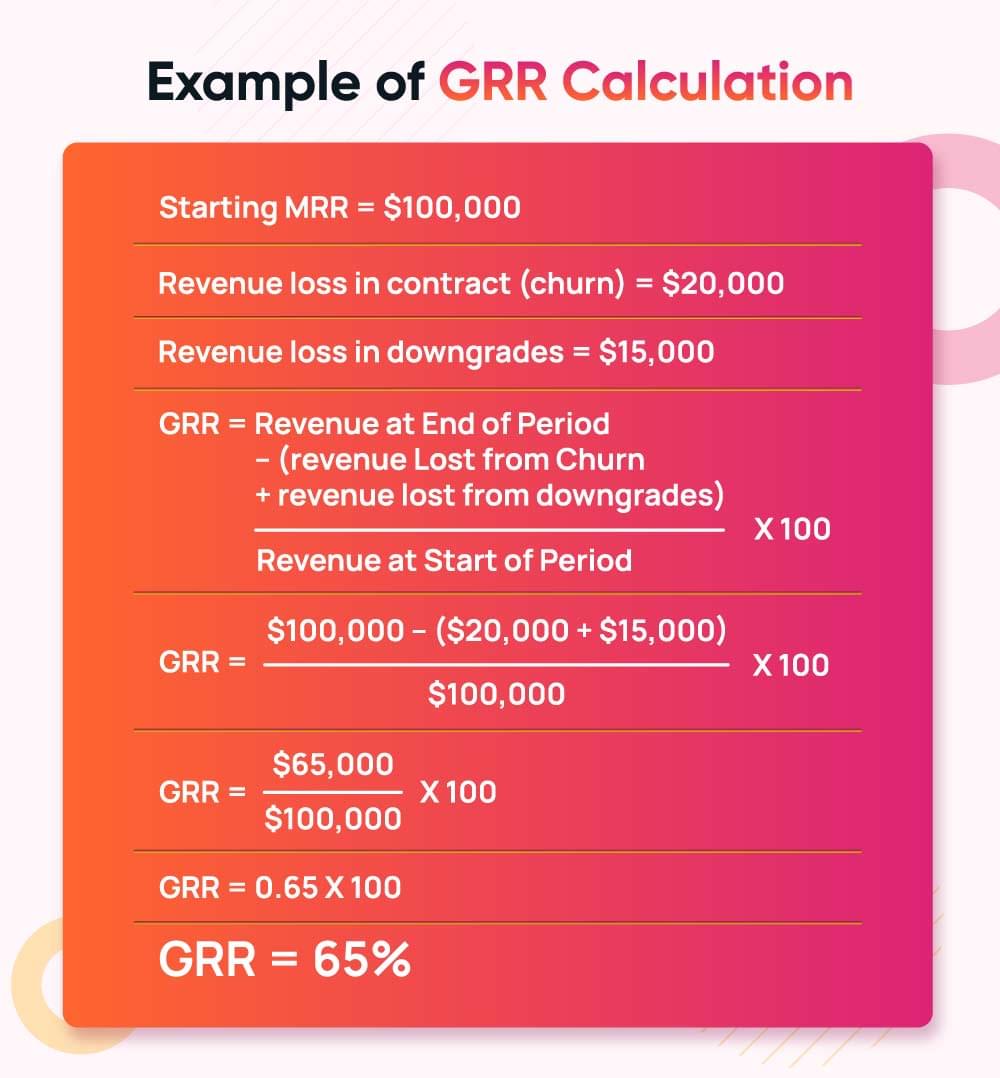
What is Gross Revenue Retention, Formula and Benchmarks

Your company’s Gross revenue retention shows how well it retains its existing revenue, excluding the influence of new customers, and helps identify whether your product or services still meet and exceed customer expectations over time.
So, when it comes to measuring customer retention, the two most important things are “How much money am I retaining?” and “How many customers/logos am I retaining?”
In this blog, we will understand what Gross Retention is, why it matters for SaaS companies, and how it can lead your business strategies toward higher profitability and long-term success.
What is Gross Retention
Gross Retention value shows the subscription renewals or repurchases of your product by existing customers over a specific period. Gross retention does not consider any new customer additions or revenue from expansion. However, it does consider your downgrades and churn. Gross retention is calculated in terms of percentage.
Subscription-based companies, especially SaaS companies, calculate gross retention and call it the percentage of existing customers or subscribers who renew or continue their subscriptions during a specific period.
A high potential for keeping an organization’s customer loyalty is shown if the gross retention rate is higher. It also shows that your business is running efficiently to reduce its churn rate and is showing positive growth.
It would be wise to consider gross retention as an essential calculation for your income statement if you are running a SaaS or subscription-based business because it tells you whether your company can maintain its existing customer base intact.
Related Read: Gross Sales on Income Statement
What is Gross Revenue Retention (GRR)
Gross revenue retention is the retained income in a specific time. GRR is the revenue that you earned from existing customers in the form of service renewals or product repurchases in a specific period.
Gross Revenue Retention (GRR) - also called Gross Dollar Retention.
Gross retention, or GRR, does not account for upsells, cross-sells, or revenue expansion from existing customers. It simply considers if your current customers extended their subscriptions at the end of a given period or not.
Gross Revenue Retention (GRR) Formula
The formula of gross revenue retention is simple. Calculate the following components before you aim to find GRR.
Starting Monthly Recurring Revenue (MRR): the expected income from existing customers in a month.
Revenue lost due to Churn
Revenue lost due to downgrades
To calculate the Gross dollar Retention, subtract the churn and downgrade revenues from the starting MRR and then divide the value by the starting MRR. Here is the formula to calculate gross dollar retention.
GRR = Starting MRR - (revenue Lost from Churn + revenue lost from downgrades)/Starting MRR
To calculate Gross Revenue Retention Rate, multiply the value by 100 or follow the equation mentioned below.
GRR Rate = (Starting MRR - (revenue Lost from Churn + revenue lost from downgrades) / Starting MRR ) x 100

How to Calculate Gross Revenue Retention
For example, if a SaaS business starts a quarter with $100,000 in its income but loses $20,000 in contracts and $15,000 in downgrades, its Gross Retention would be 65%.

This value indicates a red flag. The company is not only losing income due to churn but also due to downgrades. It needs to seriously look into its churn management and customer service strategies or its product development so that it can upsell it better.
Difference in Gross and Net Retention
Gross Retention focuses on the opening / starting revenue of your business whereas Net Retention includes expansion revenue from existing customers.
For example, if a SaaS business starts the month of May with $100,000 in their revenue and loses $20,000 in contracts but gains $30,000 in upsells, its Gross Retention would be 80%, while its Net Retention would be 110%.
This calculation indicates that the business is facing customer churn issue. Although, it has a high Net Retention but is struggling with Gross Retention due to churn.
If you are looking to understand gross vs net and how your company’s is performing at revenue growth and customer relationships, consider calculating net revenue retention or net dollar retention. Net retention includes both gross retention and any income generated from current customers through upsells, cross-sells, and expansion.
While customer retention rates, also called Logo retention rates, indicate retention in terms of the number of customers, Net Retention Rate (NRR) and Gross Retention Rate(GRR) show retention in terms of revenue retained over time. A more balanced picture of your retention can be obtained by measuring both of these indicators.
Refer to Gross vs Net Retention for more on GRR vs. NRR.
What is Good Gross Revenue Retention Benchmark
GRR greater than 85% is known to be a Good GRR
Although top level SaaS companies aim for a GRR of 90% or higher. This means that they are retaining 90% of their recurring income.
Enterprise SaaS Companies have a higher GRR, with a benchmark closer to 95% or more. This is because of their longer contracts and better customer loyalty. For mid-market SaaS or other companies, a GRR of 85% or higher is considered solid.
GRR benchmarks by ARR
Being in a SaaS business, you would know that the range of GRR benchmarks depends on the company’s Annual Recurring Revenue (ARR) and customer segments.
Here’s a table showing benchmarks of good GRR while considering the ARR.
| Annual Recurring Revenue (ARR) | Gross Revenue Retention Rate (GRR) |
|---|---|
| Less than $1M ARR | $90 |
| $1M to $5M ARR | Between 90% - 92% |
| $5M to $20M ARR | 91% |
| ARR > $20M | Between 91% - 95% |
According to a 2022 SaaS Industry Report by OpenView, successful SaaS companies aim for a Gross Retention rate of over 90%, while industry benchmarks suggest anything below 80% is a red flag.
Common Risks in Maintaining High Gross Retention and How to Avoid Them
GRR might not be a big calculation on your income statement, but if you aim to improve it, you will be surprised how deeply it is rooted in the revenue and customer loyalty strategies of your company. Despite its importance, many companies struggle with Gross Retention due to factors like:
Poor onboarding experience, which leads to early-stage churn. According to a study by the Customer Success Association, nearly 50% of all customer churn can be traced back to ineffective onboarding and engagement.
Product offers are not aligned with customer expectations which results in disappointment, leading to churn or downgrades.
Customers do not get sufficient support or you have forgotten to proactively engage once they are on-board.
You can avoid these pitfalls by carefully establishing strategies to improve customer journey. This approach helps monitor all customer touchpoints. Consider using customer feedback and churn surveys from platforms like Churnfree. You will be glad to see how useful and effective they are offering at Churnfree.
Conclusion

You can understand your business’s customer satisfaction and loyalty with GRR; however, it should not be analyzed in isolation. Try and pair it with your Net Retention value, Customer Acquisition Cost, Average CAC, and Customer Lifetime Value CLTV. This approach will provide you with a detailed view of your company’s health and long-term growth potential.
Related Read:


